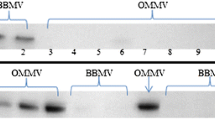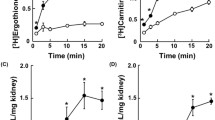Abstract
Transport processes are the hallmark of functioning kidney. Various nephrotoxicants disrupt the transport processes to manifest nephrotoxicity. Of several nephrotoxicants, mercuric chloride (HgCl2) depletes the reduced glutathione (GSH) in kidney and has been observed to affect the in vitro p-aminohippurate (PAH) transport by basolateral (BL) membrane vesicles. The role of renal nonprotein sulfhydryls such as, reduced GSH has been demonstrated to affect the PAH transport by BL membrane vesicles. The role of protein sulfhydryls in transport process of PAH by BL membrane is not known. Due to mercury mediated effects on sulfhydryls, the effects of protein-sulfhydryls (–SH) modifying reagents in the current study were investigated on PAH transport by BL membrane. It was observed that modification of –SH by p-chloromercuribenzoate sulphate (pCMBS), and mercuric chloride (HgCl2) decreased while recovering the protein –SH with dithiothreitol treatment provided protection against the effects of pCMBS, and HgCl2 on PAH transport by BL membrane vesicles.



Similar content being viewed by others
References
Ansari RA, Thakran RS, Berndt WO (1990) The effects of mercuric chloride on transport by brush border and basolateral membrane vesicles isolated from rat kidney. Toxicol Appl Pharmacol 106:145–153
Ansari RA, Thakran RS, Berndt WO (1991) Effects of mercuric chloride on renal plasma membrane function after depletion or elevation of renal glutathione. Toxicol Appl Pharmacol 111:364–372
Astorga B, Wunz TM, Morales M, Wright SH, Pelis RM (2011) Differences in the substrate binding regions of renal organic anion transporters 1 (OAT1) and 3 (OAT3). Am J Physiol Renal Physiol 301:F378–F386
Baggett JM, Berndt WO (1986) The effect of depletion of nonprotein sulfhydryls by diethyl maleate plus buthionine sulfoximine on renal uptake of mercury in the rat. Toxicol Appl Pharmacol 83:556–562
Baker MA, Cerniglia GJ, Zaman A (1990) Microtiter plate assay for the measurement of glutathione and glutathione disulfide in large numbers of biological samples. Anal Biochem 190:360–365
Boumendil-Podevin EF, Podevin RA (1983) Isolation of basolateral and brush-border membranes from the rabbit kidney cortex. Vesicle integrity and membrane sidedness of the basolateral fraction. Biochim Biophys Acta 735:86–94
Bradford MM (1976) A rapid and sensitive method for the quantitation of microgram quantities of protein utilizing the principle of protein-dye binding. Anal Biochem 72:248–254
Dantzler WH, Bentley SK (1983) Effects of sulfhydryl reagent, p-chloromercuribenzoate, on p-aminohippurate transport by isolated, perfused snake renal tubules. Renal Physiol 6:209–217
Esteva-Font C, Ballarin J, Fernandez-Llama P (2012) Molecular biology of water and salt regulation in the kidney. Cell Mol Life Sci 69:683–695
Hori R, Takano M, Okano T, Inui K (1985) Transport of p-aminohippurate, tetraethylammonium and D-glucose in renal brush border membranes from rats with acute renal failure. J Pharmacol Exp Ther 233:776–781
Hosoyamada M, Sekine T, Kanai Y, Endou H (1999) Molecular cloning and functional expression of a multispecific organic anion transporter from human kidney. Am J Physiol 276:F122–F128
Houston MC (2011) Role of mercury toxicity in hypertension, cardiovascular disease, and stroke. J Clin Hypertens (Greenwich) 13:621–627
Jensen RE, Berndt WO (1988) Epinephrine and norepinephrine enhance p-aminohippurate transport into basolateral membrane vesicles. J Pharmacol Exp Ther 244:543–549
Klonne DR, Johnson DR (1983) Amelioration of mercuric chloride-induced acute renal failure by dithiothreitol. Toxicol Appl Pharmacol 70:459–466
Lash LH (2011) Renal membrane transport of glutathione in toxicology and disease. Vet Pathol 48:408–419
Lee HY, Kim KR, Woo JS, Kim YK, Park YS (1990) Transport of organic compounds in renal plasma membrane vesicles of cadmium intoxicated rats. Kidney Int 37:727–735
Lenaz G (2012) Mitochondria and reactive oxygen species. Which role in physiology and pathology? Adv Exp Med Biol 942:93–136
McDowell EM, Nagle RB, Zalme RC, McNeil JS, Flamenbaum W, Trump BF (1976) Studies on the pathophysiology of acute renal failure. I. Correlation of ultrastructure and function in the proximal tubule of the rat following administration of mercuric chloride. Virchows Arch B Cell Pathol 22:173–196
Montagna G, Hofer CG, Torres AM (1998) Impairment of cellular redox status and membrane protein activities in kidneys from rats with ischemic acute renal failure. Biochim Biophys Acta 1407:99–108
Reid G, Wolff NA, Dautzenberg FM, Burckhardt G (1998) Cloning of a human renal p-aminohippurate transporter, hROAT1. Kidney Blood Press Res 21:233–237
Riedmaier AE, Nies AT, Schaeffeler E, Schwab M (2012) Organic anion transporters and their implications in pharmacotherapy. Pharmacol Rev 64:421–449
Scatena R (2012) Mitochondria and drugs. Adv Exp Med Biol 942:329–346
Sekine T, Watanabe N, Hosoyamada M, Kanai Y, Endou H (1997) Expression cloning and characterization of a novel multispecific organic anion transporter. J Biol Chem 272:18526–18529
Sweet DH, Wolff NA, Pritchard JB (1997) Expression cloning and characterization of ROAT1. The basolateral organic anion transporter in rat kidney. J Biol Chem 272:30088–30095
Tanaka K, Zhou F, Kuze K, You G (2004) Cysteine residues in the organic anion transporter mOAT1. Biochem J 380:283–287
Tse SS, Bildstein CL, Liu D, Mamelok RD (1983) Effects of divalent cations and sulfhydryl reagents on the p-aminohippurate (PAH) transporter of renal basal-lateral membranes. J Pharmacol Exp Ther 226:19–26
Zalme RC, McDowell EM, Nagle RB, McNeil JS, Flamenbaum W, Trump BF (1976) Studies on the pathophysiology of acute renal failure. II. A histochemical study of the proximal tubule of the rat following administration of mercuric chloride. Virchows Arch B Cell Pathol 22:197–216
Acknowledgments
Ansari, R.A. is grateful to Dr. William O. Berndt for his support of the study.
Author information
Authors and Affiliations
Corresponding author
Additional information
William O. Berndt: Published posthumously to honor who passed away in 2005.
Rights and permissions
About this article
Cite this article
Ansari, R.A., Rizvi, S.A.A., Husain, K. et al. Effect of Sulfhydryl Modification on Rat Kidney Basolateral Plasma Membrane Transport Function. Bull Environ Contam Toxicol 89, 699–703 (2012). https://doi.org/10.1007/s00128-012-0756-y
Received:
Accepted:
Published:
Issue Date:
DOI: https://doi.org/10.1007/s00128-012-0756-y




